Network Cabling
Cat5, Cat5e, Cat6, Cat6a, Cat7, Cat7a vs Cat8 Ethernet Cable, What is the difference?
Updated on December 21, 2023
Table of Contents
- What is an ethernet cable?
- What is cat 4 cable?
- What is cat 5 cable?
- What is cat 5e cable?
- What is cat 6 cable?
- What is cat 6a cable?
- What is cat 6e cable?
- What is cat 7 cable?
- What is cat 7a cable?
- What is cat 8 cable?
- Cat 5 vs Cat 6
- Cat 5 vs Cat5e
- Cat5e vs Cat6
- Cat6 vs Cat6a
- How to choose
- FAQ
- Final words
You may have just moved into a newly built house or office and must wire that place. You’re considering which network cables to install. But you don’t have any clue about them and are full of doubts. However, there are a variety of Ethernet cables on the market, such as Cat5, Cat5e, Cat6, Cat6a, Cat7, Cat7a, Cat8, etc.
It can be overwhelming with so many different Ethernet cables.
Which Ethernet cable should you choose?
Should you buy the latest Cat8 cable or go with an older version – Cat7a, Cat7, Cat6, Cat6a, Cat5e, or Cat5?
To make this decision, you must know the differences between these network cables.
So, to choose the correct network cable, you need to understand its features, differences, and capabilities. In modern times, most networks still operate primarily on Ethernet. Even the most advanced networks worldwide still utilize devices that require an Ethernet connection. There is no getting around this.
This article will introduce the basics and compare the differences in these Ethernet cables and their performance and cost to help you make the right decision. This article will also suggest usage scenarios for each Ethernet cable type.
What is an Ethernet Cable?
First, look at Ethernet cables and the twisted pair cables used for local area networks.
Ethernet cables are usually used within wired networks to connect devices (computers, routers, game switches, etc.) to the internet and each other to form a local area network.
Remember that many modern laptops and tablets do not have an Ethernet port, so you must buy an adapter to connect them by wired means. In any case, an Ethernet cable allows you to access your network's Internet and other devices.
Ethernet cables connect devices in a local area network and connect devices in that network to the internet. Ethernet cables are used for hard-wired Internet connections because wireless Internet is more susceptible to interference and lag, which can lead to unstable connections.
Other electronic devices, such as microwave ovens, can interfere with the signal for some types of wireless internet. In other cases, a brick wall between your device and the WiFi router can cause problems with your connection. Even being too far away from the router can cause a slow connection.
The different types of Ethernet cables – Cat5, Cat5e, Cat6, Cat6a, Cat7, Cat7a, and Cat8 – differ in their specifications. These cables are designed to match different Internet speeds and network standards.
What is a Cat4 Ethernet Cable?
Cat 4 cable, defined by ANSI/EIA/TIA 568 and ISO/IEC 11801 specifications, is a twisted pair cable for telecommunication networks and some computer networks with a transmission bandwidth of 20MHz and a maximum data rate of 16Mbps, mainly for token-based LANs and twisted pair Ethernet (10BASE-T/100BASE-T), but has been phased out by the standard.
What is a Cat5 Ethernet Cable?
Also known as an Ethernet or LAN cable, Cat 5 or Category 5 is a network cable consisting of four twisted copper wires terminated by RJ-45 connectors. They are used in home and business networks and provide data transfer speeds of up to 100 Mbps.
The maximum recommended length of a Cat 5 cable is 100 meters. While some offices set up “a long time ago” may still use Cat 5, Cat 5 Ethernet cables are obsolete and have been replaced by Cat 5e Ethernet cables, a more robust and enhanced upgrade cable.
In terms of performance, the Cat5 Ethernet cable has a standard bandwidth of 100 MHz and a maximum length of 100 meters, providing connection speeds of up to 100 Mbps. This is relatively low by modern standards, usually starting at 1 Gbps. After all, the point of a hard-wired connection is reliability and speed.
Cat5 Ethernet cables consist of two twisted-pair, color-coded copper pairs. They are less durable and interference-resistant than other Ethernet cables because Cat5 cables do not have insulation to provide better protection.
What is a Cat5e Ethernet Cable?
Cat5e is the upgraded Cat5, also called Cat5 Enhanced. This network cable standard was approved for use in 1999. Similar to Cat5 in the structure and price, but with enhanced performance in max data rate. Cat5e supports data transmission speeds of one gigabit per second (Gbps), a frequency of 100 MHz, and a maximum length of 100 meters (328 feet). Which provides a ten times faster speed than the common Cat5.
Besides the speed, the Cat5e also improves the crosstalk performance between the wires in the cable. That reduces the chance of interference and transmission errors. Of course, it will provide capable performance for most applications today, but Cat5e also leaves fewer opportunities for future upgrades.
What is a Cat6 Ethernet Cable?
Cat6 cable is also called “Category 6” Ethernet cable. Cat6 is another improved version of the previous Cat5e. It consists of four pairs of copper wires and supports Ethernet connections up to 10Gbps. Under normal circumstances, within a range of 100 meters, it supports a maximum transmission speed of up to 1 Gbps.
The Cat6 cable supports 37-55 meters (depending on crosstalk) when transmitting at 10Gbps (10GBASE-T). It can transmit frequencies up to 250MHz, indicating the frequency at which the signal can pass through the cable.
More importantly, it uses RJ-45 standard connectors and is backward compatible with its previous versions, such as Cat5 and Cat5e. Cat6 cables are generally very affordable, and their speed is ten times that of Cat5e cables. However, their prices are higher than Cat5e cables, and they are also relatively short.
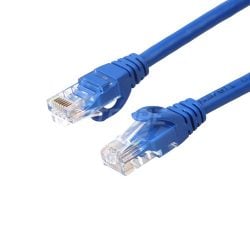
Some upgrades in the design of the Cat6 Ethernet cable also make it an improvement over the previous version.
First, the wire pairs are wound tighter, including more twists per centimeter (two or more twists per centimeter- the exact number varies depending on the model). This can further reduce crosstalk and interference.
In addition, Cat6 Ethernet cables may include a plastic core in the middle for better separation of wires, which is expected to obtain more precise signals and aluminum foil insulation. Cat6 cables have a thicker sheath than Cat5e cables. The thicker sheath reduces the chance of alien crosstalk (AXT) and near-end crosstalk (NEXT).
Most Cat6 cables are flat, so if you need to stick them on the wall, guide them through narrow corners, or let them blend into the background as much as possible, they are pretty convenient. After all, one of the most visual headaches with Cat5e cables is that it is just there.
What is a Cat6a Ethernet Cable?
Cat6a cable is an enhanced version of the Cat6 Ethernet cable. This enhanced Cat6 cable includes a higher standard bandwidth, starting at 500 MHz and going up to 550 MHz. This standard bandwidth is twice that of Cat6, which carries significant consequences. Chief among them is that Cat6A can maintain a data rate of 10 Gbps over distances of up to 100 meters. That’s about twice the difference between Cat6.
If you want to set yourself up for a successful long-term Gigabit Ethernet network, Cat6a (Category 6 Enhanced) is the right choice. Yes, it’s more expensive than Cat5e or Cat6, but as the technology evolves, the hardware you’ll connect to your network will only get more complex, not less. Cat6a supports the same 10Gbps transmission speed as Cat6, but up to 328 feet and at 500MHz. Of course, there’s less crosstalk than Cat6.
Cat6a Ethernet cables also come with a more robust jacket that reduces and eliminates AXT (extraneous crosstalk) and improves the quality of the SNR (signal-to-noise ratio). Cat6a cables have reduced crosstalk and are more likely to give you the maximum possible speed of 10Gbps.
-
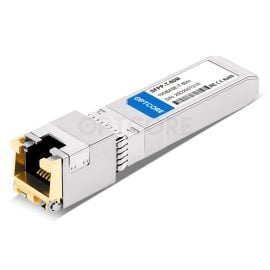 MikroTik S+RJ10-100 Compatible 10GBASE-T SFP+ RJ45 Copper 100m TransceiverUS$ 44.00 (Excl. VAT)
MikroTik S+RJ10-100 Compatible 10GBASE-T SFP+ RJ45 Copper 100m TransceiverUS$ 44.00 (Excl. VAT) -
 F5 F5-UPG-SFP+-TX-100M Compatible 10GBASE-T SFP+ RJ45 Copper 100m TransceiverUS$ 44.00 (Excl. VAT)
F5 F5-UPG-SFP+-TX-100M Compatible 10GBASE-T SFP+ RJ45 Copper 100m TransceiverUS$ 44.00 (Excl. VAT) -
 Palo Alto PAN-SFP-PLUS-10GBASE-T-100M Compatible 10GBASE-T SFP+ RJ45 Copper 100m TransceiverUS$ 44.00 (Excl. VAT)
Palo Alto PAN-SFP-PLUS-10GBASE-T-100M Compatible 10GBASE-T SFP+ RJ45 Copper 100m TransceiverUS$ 44.00 (Excl. VAT) -
 Netgear AXM765-100 Compatible 10GBASE-T SFP+ RJ45 Copper 100m TransceiverUS$ 44.00 (Excl. VAT)
Netgear AXM765-100 Compatible 10GBASE-T SFP+ RJ45 Copper 100m TransceiverUS$ 44.00 (Excl. VAT) -
 Fortinet FN-TRAN-SFP+GC-100M Compatible 10GBASE-T SFP+ RJ45 Copper 100m TransceiverUS$ 44.00 (Excl. VAT)
Fortinet FN-TRAN-SFP+GC-100M Compatible 10GBASE-T SFP+ RJ45 Copper 100m TransceiverUS$ 44.00 (Excl. VAT) -
 Mellanox MFM1T02A-T100 Compatible 10GBASE-T SFP+ RJ45 Copper 100m TransceiverUS$ 44.00 (Excl. VAT)
Mellanox MFM1T02A-T100 Compatible 10GBASE-T SFP+ RJ45 Copper 100m TransceiverUS$ 44.00 (Excl. VAT)
What is a Cat6e Ethernet Cable?
In practice, Cat6e is uncommon, so we will briefly introduce the term in this paragraph. Cat6e is an internal specification developed by some manufacturers. The TIA or any other reputable organization or committee has not approved it. Therefore, it is not an open standard.
Cat6e refers to “Enhanced” Cat6 to denote enhanced performance beyond the original Cat6 specification. Typically, it provides a transmission frequency of 500MHz to 600MHz. It is equipped with a grounded foil shield to support data rates of 10Gbps and a transmission distance of 100 meters.
What is a Cat7 Ethernet Cable?
Cat7 cables are Category 7 cables that provide cables for Gigabit Ethernet infrastructure. It provides frequencies up to 600MHz. It is the perfect choice for wiring your smart home. After wiring, you can even check automation ideas. It supports high-speed Ethernet communications up to 10Gbps.
These are backward compatible with Cat6, Cat5, and Cat5e. It provides a 100-meter 4-connection channel with shielded wiring. They require twisted pair wires to become a fully shielded system. This system is called shielded twisted pair (SSTP) or shielded foil twisted pair (SFTP) cabling. It eliminates alien cross-talk and has better noise immunity. It allows users to obtain higher speeds with longer cables.
What is a Cat7a Ethernet Cable?
Cat7a Ethernet cable refers to “Category 7 Enhanced”, or Category F enhanced products. This was introduced by ISO 11801 Edition 2 Amendment 2 (2010) and defined frequencies up to 1000 MHz.
Category 7a cables may have been initially introduced as a future-proof step to meet the expected widespread adoption of the 40 Gbps Ethernet standard. -However, in 2016, a new approval meant that this responsibility was effectively handed over to Cat8 cables designated for 2000 MHz. As a result, cable Cat7a is not officially supported by many devices as a standalone revision.
Cat7a Ethernet cables are typically slightly thicker because of the additional shielding designed to increase the speed at which they deliver 1000 MHz. Cat7a is not technically recognized by most of today’s standards and has minimal applications. It offers speeds and distances similar to Cat7 in most everyday applications and environments. Both standards suit demanding usage scenarios, such as high-performance data center applications.
What is a Cat8 Ethernet Cable?
Cat8 Ethernet cables have made great leaps in performance and speed. Cat8 Ethernet cable can support frequencies up to 2GHz (or 2000Mhz), which is more than twice that of Cat7.
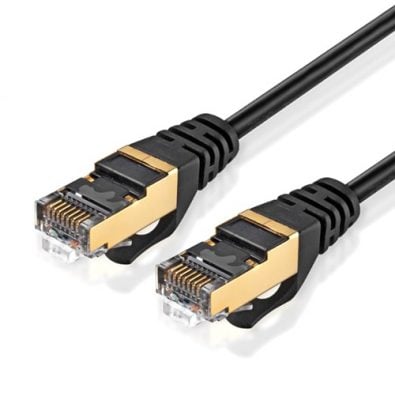
More importantly, Cat8 Ethernet cable can achieve the speed of Cat8.1 up to 25Gbps and Cat8.2 up to 40Gbps. This is a considerable upgrade to its predecessors’ speed, primarily because it can even support higher data transmission rates within a short distance of 30 meters.
Cat8 Ethernet cable is also designed as shielded wiring to reduce interference. This is achieved through S/FTP shielding with foiled twisted pair cables. The working method of this shielding is that the twisted pair is first wrapped in aluminum foil and then covered by a sturdy 4-pair woven net, which is flexible and highly durable. The braided screen design enables better grounding and usually achieves the highest performance of copper cables. Like all other Ethernet cables, Cat8 uses RJ45 connectors and is backward compatible.
Finally, at its extreme speed, Cat 8 is not designed for home use. At least not yet. To take full advantage of the speed of Cat 8, you need not only a suitable Cat 8 cable and compatible switches, routers, and network cards to support it. Similar to Cat7, it is most suitable for industrial use.
Cat5, Cat5e, Cat6, Cat6a, Cat7, Cat7a vs Cat8 Comparison
| Category | Cat5 | Cat5e | Cat6 | Cat6A | Cat7 | Cat7a | Cat8 |
| Standard Bandwidth | 100MHz (up to 350) | 100MHz (up to 350) | 250MHz (up to 550) | 500MHz (up to 550) | 600MHz | 1000MHz | 2000MHz |
| Max Data Rate | 100Mbps | 1000Mbps | 1000Mbps | 10Gbps | 10Gbps | 10Gbps | 25Gbps or 40Gbps |
| Shielding Type | UTP or STP | UTP or STP | UTP or STP | UTP or STP | Shielded only | Shielded only | Shielded only |
| Max. Cable Length | 100m | 100m | 100m | 100m(or 50m at 10Gbps) | 100m(or 50m at 40Gbps) | 100m | 30m |
| Networks Supported | 100Base-T | 1000Base-T | 1000Base-T | 10GBase-T | 10GBase-T | 10GBase-T | 25GBase-T40GBase-T |
| Cost | Low | Low | Fair | Fair | Moderate | Moderate | High |
| Comment | Considered obsolete and should not be used for new cabling. Suitable for most homes and small businesses. | Enhanced features with the best pricing for home and business networking | A good budget option for new network builds with a bandwidth that can handle most small to medium-sized businesses | A good budget option for long network builds with a bandwidth that can handle most small to medium-sized businesses | The cable is very stiff due to the extra shielding, making it difficult to bend and fish. Recommended for new builds. | Very expensive and should only be considered in-network environments where speed is very important. |
Cat5 vs Cat6 ethernet cable
The main difference between Cat 5 and Cat 6 is the transmission speed and bandwidth. Cat 5 cables usually support a transmission frequency of 100Mhz, which is suitable for applications with a transmission rate of 100Mbps.
Cat 6 cables have a transmission frequency of 250Mhz, are suitable for applications with a transmission rate of 1Gbps, and can support Gigabit networks. That is because Category 6 cables have insulated crossbones in their internal structure, which isolates the four pairs of twisted pairs, thus improving the balance of the cable and reducing signal crosstalk.
Cat5 vs Cat5e ethernet cable
The most apparent difference between them is the transmission speed. Cat5 cables support 100Mbps, while Cat5e cables support ten times the speed of Cat5 cables – 1000Mbps. In addition, the performance of Cat5e cables is improved in terms of near-end crosstalk, attenuation crosstalk ratio, return loss, etc. There is no significant difference in price, so today, Category 5 cables have been gradually replaced by Cat5e ethernet cables.
Cat5e vs Cat6 ethernet cable
Both Cat5e and Cat6 cables support 1Gbps transmission speeds. For most home networks, 1Gbps is high enough. However, if you want to upgrade to a higher 10Gbps network speed, Cat5e is not supported.
The main difference between Cat5e and Cat6 cables is the maximum transmission speed. Cat6 cable supports up to 55 meters of transmission distance at 10Gbps. This is one of the significant advantages of Cat6 cables. Cat6 cables typically cost about 20% more than Cat5e cables due to their enhanced performance and features.
-
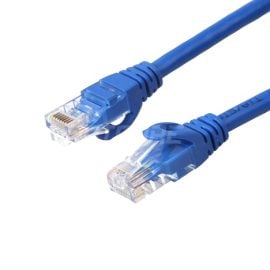 Cat5e Snagless Unshielded (UTP) Ethernet Network Patch Cable, PVC, Blue
Cat5e Snagless Unshielded (UTP) Ethernet Network Patch Cable, PVC, Blue -
Product on sale
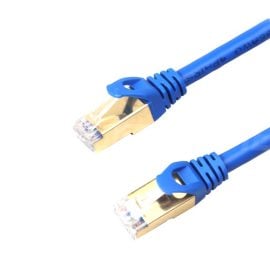 Cat6 Snagless Shielded (SFTP) Ethernet Network Patch Cable, PVC, BluePrice range: US$ 1.29 through US$ 17.70 (Excl. VAT)
Cat6 Snagless Shielded (SFTP) Ethernet Network Patch Cable, PVC, BluePrice range: US$ 1.29 through US$ 17.70 (Excl. VAT) -
 Cat7 Snagless Shielded (SFTP) Ethernet Network Patch Cable, PVC, BluePrice range: US$ 2.20 through US$ 25.80 (Excl. VAT)
Cat7 Snagless Shielded (SFTP) Ethernet Network Patch Cable, PVC, BluePrice range: US$ 2.20 through US$ 25.80 (Excl. VAT) -
 Cat8 Snagless Shielded (SFTP) 25G/40GBase-T Ethernet Network Patch Cable, PVC, BlackPrice range: US$ 2.25 through US$ 28.80 (Excl. VAT)
Cat8 Snagless Shielded (SFTP) 25G/40GBase-T Ethernet Network Patch Cable, PVC, BlackPrice range: US$ 2.25 through US$ 28.80 (Excl. VAT) -
Product on sale
 Cat6A Snagless Shielded (SFTP) Ethernet Network Patch Cable, PVC, BluePrice range: US$ 1.49 through US$ 22.35 (Excl. VAT)
Cat6A Snagless Shielded (SFTP) Ethernet Network Patch Cable, PVC, BluePrice range: US$ 1.49 through US$ 22.35 (Excl. VAT) -
 Cat6 Ethernet Network Patch Cable, Snagless Unshielded (UTP), PVC, BluePrice range: US$ 0.85 through US$ 13.10 (Excl. VAT)
Cat6 Ethernet Network Patch Cable, Snagless Unshielded (UTP), PVC, BluePrice range: US$ 0.85 through US$ 13.10 (Excl. VAT)
Cat6 vs Cat6a ethernet cable
Both cables offer excellent performance and a good price/performance ratio in real-world network applications. However, Cat6a provides faster data rates, longer distances, and better crosstalk shielding overall. Cat6 is better suited for short-haul home or business network cabling scenarios due to its excellent overall cost advantage and installation flexibility.
The core differences between the two are mainly the following.
#1: Speed and bandwidth
Cat6 cables support data rates of up to 1 Gbps over distances of up to 100 meters. Cat6a cables can handle data transfer speeds of up to 10 Gbps over longer distances of up to 100 meters. All things being equal, the latter offers ten times the transmission speed.
#2: Cable thickness
Cat6a is typically thicker and bulkier than Cat6 cable. As a result, Cat6a’s installation flexibility could be improved. Instead, Cat6 is better suited for use in tight spaces or when bending around corners.
#3: Applications
The difference in performance and cost determines the different application scenarios. Cat6 cables are suitable for home and SOHO networks that do not require high speeds, such as for daily office communications, Internet browsing, streaming media, and occasional online gaming.
For large offices or data centers that require higher speeds and distances, Cat6a comes into play. Cat6a’s speed advantages and enhanced shielding provide significant network performance for high service throughput.
How to choose: Cat5, Cat5e, Cat6, Cat7, Cat7a, or Cat8 cable?
By understanding these Ethernet cables’ features, differences, and costs, we should know how to choose the right one. For most home and small office/home office (SOHO) networks, Cat5e cable should be your minimum.
If you are a small to medium-sized business with dozens of computer users and servers, then Cat6 and Cat6a cables are recommended. It is affordable and provides enough bandwidth for typical business network traffic and the best price/performance ratio.
For high-speed switch-to-switch communication in a 25G or 40G network, a Cat7 or Cat8 cable is a better choice. Although expensive, you can achieve faster speeds, higher durability, and lower interference rates, ultimately helping you ensure productivity.
FAQ
Q: When will the cat9 cable be available?
A: There is no approved standard for cat9 cable. Maybe you can expect them in the following years. However, CAT8 is fast enough for most enterprise-class high-speed network applications.
Q: Is cat8 backward compatible?
A: The category 8 cable is fully backward compatible with Cat5e, Cat6, and cat6a cables.
Q: Is cat8 worth it?
A: This depends on the usage scenario. Cat6 or cat6a is sufficient for most home users, and they both support 10Gbps (cat6 55m and cat6a to 100m). However, if you plan to implement a high-speed Fiber-over-Ethernet or Fibre Channel over an Ethernet network in your home, you may consider Cat8. For more significant enterprise users, who may have a 25Gbps or 40Gbps network, the more expensive Cat8 cable is necessary.
Q: Will Cat 8 work with my router?
Sure. However, for most home uses, Cat 6a is more than adequate. Because most home network equipment cannot run at Cat 8 speeds, Cat 8 cable is unnecessary. Cat 8 cable is ideal for data center applications since it is far faster than most people require. Unless your network is equipped with CAT8-compatible devices, you will still not enjoy the speed and benefits of CAT8 with CAT8 cables.
Q: Is cat 8 good for gaming?
Strictly speaking, cat8 can provide better performance. But in reality, most games require no more than 100 Mbps, so in this case, even with a cat8 cable, you won’t feel a significant difference. That’s when Cat 5e is the most economical.
Q4: Is Cat6 or Cat6a better for the home network?
There is no definitive answer. It depends on your network requirements. However, 10Gbps is enough for most home networks and future upgrades. Therefore, most users will not need to deploy bulky and expensive Cat6a cables, and Cat6 is the most practical option.
Final Words
In this article, we’ve gone over as many different types of network cables and how they differ as possible. Do you know how to choose the most appropriate cable for your network? Do you have any questions? Please leave a comment and let us know.
As a one-stop supplier for high-speed interconnectivity, OPTCORE offers various ethernet cables in different combinations of lengths, colors, and styles. Our broad portfolio of products will meet your network cabling needs. All cables are constructed with pure copper, providing excellent performance and guaranteeing stable and high-speed network operation.
Read more:
- UTP vs. STP vs. FTP vs. S/FTP Cable, What is The Difference
- PoE Ethernet Switch vs. PoE Router vs. PoE Media Converter vs. PoE Injector vs. PoE Splitter Comparison
- A Quick Guide to 10G Fiber Media Converter
- Teardown Report: OPTCORE SFP to Ethernet Media Converter
- FAQs About 10GBASE-T SFP+ Transceiver – Everything You Need To Know

 Español
Español 日本語
日本語 Français
Français






very useful information. Thank you.